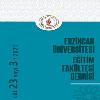Zihin teorisi ve ahlaklılık kazanımı arasındaki ilişki
Bu çalışmada, zihin teorisi ile ahlaklılık kazanımı arasındaki bazı ilişkiler incelenmiştir. Yaygın bir kavram olan zihin teorisi, insanların davranışlarının inançlar, istekler, planlar ve niyetler gibi içsel zihni durumlar tarafından yönlendirildiğini anlamayı içerir. Gelişmiş bir zihin teorisine sahip olmak, insan davranışlarının zihni kavramların sonucu olduğu bilincine varmayı sağlar. Zihni durumları içerdiğinden ötürü zihin teorisinin ahlaki idrak ile ilişkili olduğu yaygın bir şekilde kabul edilir. Bu ilişki, bir kişinin bir başka kişinin davranışının kasıtlı olup olmadığını yargılama sürecinde ortaya çıkar. Literatür taramasından, zihin teorisi yeteneğinin ahlakla ilgili yargılamalar için gerekli olan niyeti anlama, ahlakiliğin bir yönü olan özgecilik ve kişinin kendisi ile ilgili ahlaki duygularının farkına varma yeteneği için temel oluşturduğu anlaşılmaktadır. Bu çalışmada değinilmeyen zihin teorisi ile ahlaklılık kazanımı arasındaki diğer ilişkilerin incelenmesi, gelecekte yapılması muhtemel çalışmalar için tavsiye edilmiştir.
The relationship between theory of mind and acquisition of morality
In this paper, some of the links between theory of mind and acquisition of morality are examined. Theory ofjmind is a widespread concept that entails the understanding that internal mental states, such as beliefs, hopes, desires, plans, and intentions rule people's behavior. Having a well-developed theory of mind provides awareness that human actions are consequences of mental concepts. Because theory of mind involves mental states, it is widely acknowledged that theory of mind and moral cognition are connected. Such connection takes place in the process of a person's judgment about whether another person's action is intentional. Literature review reveals that theory of mind ability provides the basis for understanding intention that is necessary for moral judgments, as well as for the aspects of morality such as altruism, and being able to recognize self-conscious emotions that involve morality. Future research should examine the other links between theory of mind and acquisition of morality that are not mentioned in this study.
___
- Astington, J. W. (1998). Theory of mind, Humpty, and the icebox. Human Development, 41, 30-39.
- Baron-Cohen, S. (1988). "Without a theory of mind one cannot participate in a conversation." Cognition, 29, 83-84.
- Bloom, P., German, T. P. (2000). Two reason to abandon the false belief task as a test of theory of mind. Cognition, 77, B25-B31.
- Bukatko, D., Daehler, M. W. (1998). Child development. Boston: Houghton Mifflin Company.
- Carlson, S.M., Moses, LJ. (2001). Individual differences in inhibitory control and children's theory of mind. Child Development, 72, 1032-1053.
- Eisenberg, N., (2000). Emotion, regulation, and moral development. Annual Review of Psychology, 51, 665-697.
- Gopnik, A., Wellman, H. M. (1992). Why the child's theory of mind really is a theory. Mind and Language, 7, 145-171.
- Haidt, J., 2003. The moral emotions. In Davidson, R.J., Scherer, K.R., Goldsmith, H.H. (Eds.), Handbook of Affective Sciences. Oxford Univ.Press, Oxford, pp. 852- 870.
- Harris, P. L. (1992). From simulation to folk psychology: The case for development. Mind ve Language, 7, 120-144.
- Heerey, E.A., Keltner, D., Capps, L.M., 2003. Making sense of selfconscious emotion: linking theory of mind and emotion in children with autism. Emotion, 3, 394- 400.
- James, M. (2004). Blaming mindreaders: Intentional action, moral responsibility, and theory of mind. Unpublished dissertation. Retrieved March 10, 2006, from http://etd.lib.fsu.edu/theses/available/etd-07122004-30806/unrestricted/ Thesis, pdf
- Jarrold, C, Carruthers, P., Smith, P. K., Boucher, J. (1994). Pretend play: Is it metarepresentationaY! Mind and Language, 9, 445-468.
- Knobe, J. (2005). Theory of mind and moral cognition: exploring the connections. TRENDS in Cognitive Sciences, 9, 357-359.
- Leslie, A. M. (1994). ToMM, ToBy, and Agency: Core architecture and domain specificity. In L. A. Hirschfield ve S. A. Gelman (Eds.), Mapping the mind: Domain specificity in cognition and culture (pp. 119-148). Cambridge, UK: Cambridge University Press.
- Moore, C, Frye, D. (1991). The acquisition and utility of theories of mind. In D. Frye ve C. Moore (Eds.), Children's theories of mind: Mental states and social understanding (pp. 1-14). Hillsdale, NJ: Lawrence Erlbaum.
- Moses, L. J. ve Flavell, J. H. (1990). Inferring false beliefs from actions and reactions. Child Development, 61, 929-945.
- Perner, J., Leekam, S. R., Wimmer, H. (1987). Three-year-olds' difficulty understanding false belief: The case for a conceptual deficit. British Journal of Developmental Psychology, 5, 125-137.
- Premack, D., Woodruff, G. (1978). Does the chimpanzee have a theory of mind? The Behavioral and Brain Sciences, 4, 515-526.
- Takahashi, H., Yahata, N., Koeda, M., Matsuda, T., Asai, K., Okubo, Y. (2004). Brain activation associated with evaluative processes of guilt and embarrassment: an fMRI study. Neurolmage, 23, 967- 974.
- Tangney, J.P., Dearing, R.L. (2002). Shame and Guilt. Guilford Press, New York.
- Wellman, H. M. (1991). From desires to beliefs: Acquisition of a theory of mind. In A. Whiten (Ed.-), Natural theories of mind: Evolution, development and simulation of everyday mindreading (pp. 19-38). Cambridge, MA: Basil Blackwell.
- Wellman, H. M. (1992). The child's theory of mind. MIT Press: Massachusetts.
- Wimmer, H., Perner, J. (1983). Beliefs about beliefs: Representation and constraining function of wrong beliefs in young children's understanding of deception. Cognition, 13, 103-128.
- Yayın Aralığı: Yılda 4 Sayı
- Başlangıç: 1999
- Yayıncı: Erzincan Binali Yıldırım Üniversitesi
Sayıdaki Diğer Makaleler
Oruç Ali UĞUR, Murat AKYÜZ, Mustafa YILDIZ, Murat TEKİN
CELAL ED-DİN HAREZMŞAH’IN GÜRCİSTAN’DAKİ FAALİYETLERİ
Zihin teorisi ve ahlaklılık kazanımı arasındaki ilişki
TÜRKİYE’NİN DÜNYA MİRASI LİSTESİ’NDEKİ YERİ VE YENİ BİR ADAY ÖNERİSİ
HAFİK GÖLÜ VE YAKIN ÇEVRESİNİN TURİZM OLANAKLARI
Erdal AKPINAR, Gülpınar AKBULUT
Emine ÇİL, Yusuf SÜLÜN, Burcu ŞENLER, Kozcu Nevin ÇAKIR
